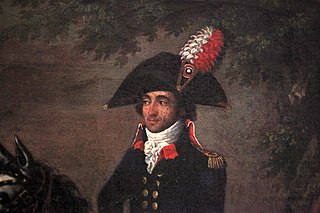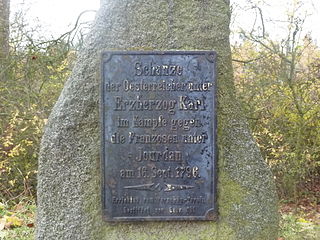
The Battle of Aldenhoven or Battle of the Roer saw a Republican French army commanded by Jean Baptiste Jourdan defeat a Habsburg army under François Sébastien Charles Joseph de Croix, Count of Clerfayt which was defending the line of the Roer River. A key crossing was won by the French right wing at Düren after heavy fighting. The Austrian retreat from the Roer conceded control of the west bank of the Rhine River to France. The battle occurred during the War of the First Coalition, part of a wider conflict called the Wars of the French Revolution. Aldenhoven is located in the state of North Rhine-Westphalia in Germany about 21 kilometres northeast of Aachen.

The Battle of Amberg, fought on 24 August 1796, resulted in an Habsburg victory by Archduke Charles over a French army led by Jean-Baptiste Jourdan. This engagement marked a turning point in the Rhine campaign, which had previously seen French successes.

François Séverin Marceau-Desgraviers was a French general of the Revolutionary Wars.

Baron Paul Kray of Krajova and Topolya, was a soldier, and general in Habsburg service during the Seven Years' War, the War of Bavarian Succession, the Austro–Turkish War (1787–1791), and the French Revolutionary Wars. He was born in Késmárk, Upper Hungary.

The Army of Sambre and Meuse was one of the armies of the French Revolution. It was formed on 29 June 1794 by combining the Army of the Ardennes, the left wing of the Army of the Moselle and the right wing of the Army of the North. Its maximum paper strength was approximately 120,000.

The Battle of Würzburg was fought on 3 September 1796 between an army of the Habsburg monarchy led by Archduke Charles, Duke of Teschen and an army of the First French Republic led by Jean-Baptiste Jourdan. The French attacked the archduke's forces, but they were resisted until the arrival of reinforcements decided the engagement in favor of the Austrians. The French retreated west toward the Rhine River. The action occurred during the War of the First Coalition, part of the French Revolutionary Wars. Würzburg is 95 kilometres (59 mi) southeast of Frankfurt.

The Army of the Rhine and Moselle was one of the field units of the French Revolutionary Army. It was formed on 20 April 1795 by the merger of elements of the Army of the Rhine and the Army of the Moselle.

Maximilian, Count von Merveldt, among the most famous of an illustrious old Westphalian family, entered Habsburg military service, rose to the rank of General of Cavalry, served as Francis II, Holy Roman Emperor's ambassador to Russia, and became special envoy extraordinaire to the Court of St. James's. He fought with distinction in the wars between the Habsburg and the Ottoman empires, the French Revolutionary Wars, and the Napoleonic Wars.

The Battle of Ettlingen or Battle of Malsch was fought during the French Revolutionary Wars between the armies of the First French Republic and Habsburg Austria near the town of Malsch, 9 kilometres (6 mi) southwest of Ettlingen. The Austrians under Archduke Charles, Duke of Teschen tried to halt the northward advance of Jean Victor Marie Moreau's French Army of Rhin-et-Moselle along the east bank of the Rhine River. After a tough fight, the Austrian commander found that his left flank was turned. He conceded victory to the French and retreated east toward Stuttgart. Ettlingen is located 10 kilometres (6 mi) south of Karlsruhe.

In the Rhine campaign of 1796, two First Coalition armies under the overall command of Archduke Charles outmaneuvered and defeated two French Republican armies. This was the last campaign of the War of the First Coalition, part of the French Revolutionary Wars.

The Battle of Altenkirchen saw two Republican French divisions commanded by Jean Baptiste Kléber attack a wing of the Habsburg Austrian army led by Duke Ferdinand Frederick Augustus of Württemberg. A frontal attack combined with a flanking maneuver forced the Austrians to retreat. Three future Marshals of France played significant roles in the engagement: François Joseph Lefebvre as a division commander, Jean-de-Dieu Soult as a brigadier and Michel Ney as leader of a flanking column. The battle occurred during the War of the First Coalition, part of a larger conflict called the Wars of the French Revolution. Altenkirchen is located in the state of Rhineland-Palatinate in Germany about 50 kilometres (31 mi) east of Bonn.

Sometimes called the Battle of Limburg or Second Battle of Altenkirchen or Battle of the Lahn, this was actually a single-day battle followed by a lengthy rear-guard action. The action occurred during the War of the First Coalition, part of a wider conflict known as the French Revolutionary Wars. Limburg an der Lahn is located in the state of Hesse in Germany about 31 miles (50 km) east of Koblenz. On 16 September, the Habsburg Austrian army commanded by Archduke Charles, Duke of Teschen attacked a Republican French army led by Jean-Baptiste Jourdan in its positions behind the Lahn River. The unexpected collapse and withdrawal of their right flank on the evening of the 16th compelled the French to make a fighting withdrawal that began in the evening of the 16th and continued until late on 19 September.
The Battle of Wetzlar saw a Habsburg Austrian army led by Archduke Charles, Duke of Teschen launch an attack on a Republican French army under Jean-Baptiste Jourdan in its defenses on the Lahn River. The War of the First Coalition action ended in an Austrian victory when most of the French army began retreating to the west bank of the Rhine River. On the 19th the combat of Uckerath was fought as the Austrians pursued the French left wing. Wetzlar is located in the state of Hesse in Germany a distance of 66 kilometres (41 mi) north of Frankfurt.

During the Battle of Kehl, a Republican French force under the direction of Jean Charles Abbatucci mounted an amphibious crossing of the Rhine River against a defending force of soldiers from the Swabian Circle. In this action of the War of the First Coalition, the French drove the Swabians from their positions in Kehl and subsequently controlled the bridgehead on both sides of the Rhine.
Louis Bastoul was a general French in the French Revolutionary Wars. He was born in Montolieu 19 August 1753, and died in Munich on 15 January 1801, of wounds received at the Battle of Hohenlinden.
Jean Castelbert de Castelverd commanded a French division during the French Revolutionary Wars until he lost his nerve during a 1796 battle and was dismissed. In 1792 he assumed command of a volunteer unit. He fought in the War of the Pyrenees against the Kingdom of Spain, winning promotion to general of brigade in 1793 and general of division in 1795. The following year he and his division were sent from Belgium to reinforce the Army of Sambre-et-Meuse which was defending the line of the Lahn River. In the Battle of Limburg in September 1796 he abandoned his position in disobedience to orders even though his troops were not under enemy pressure. He was soon removed from command and retired from the army in 1801.

The Battle of Maudach occurred on 15 June 1796 between the French Revolutionary Army and the Army of the First Coalition. This was the opening action of the Rhine Campaign of 1796 on the Upper Rhine, slightly north of the town of Kehl. The Coalition, commanded by Franz Petrasch, lost 10 percent of its manpower missing, killed or wounded. It was fought at the village of Maudach, southwest of Ludwigshafen on the Rhine river opposite Mannheim. Maudach lies 10 km (6 mi) northwest of Speyer and today is a southwest suburb of Ludwigshafen; a principal town on the Rhine river in 1796.
In the Rhine Campaign of 1796, two First Coalition armies under the overall command of Archduke Charles outmaneuvered and defeated two Republican French armies. This was the last campaign of the War of the First Coalition, part of the French Revolutionary Wars.

The Battle of Siegburg was the first engagement of the French offensive across the River Rhine - that offensive was to become the main campaign of 1796 during the War of the First Coalition. On 30 May 1796 général de division Jean-Baptiste Kléber crossed the river at Düsseldorf with the two divisions commanded by général de division Lefebvre and général de division Colaud. He then moved on Siegburg, where he won the battle on 1 June, thus enabling general Jean-Baptiste Jourdan to bring the bulk of his force across the Rhine at Neuwied.


















